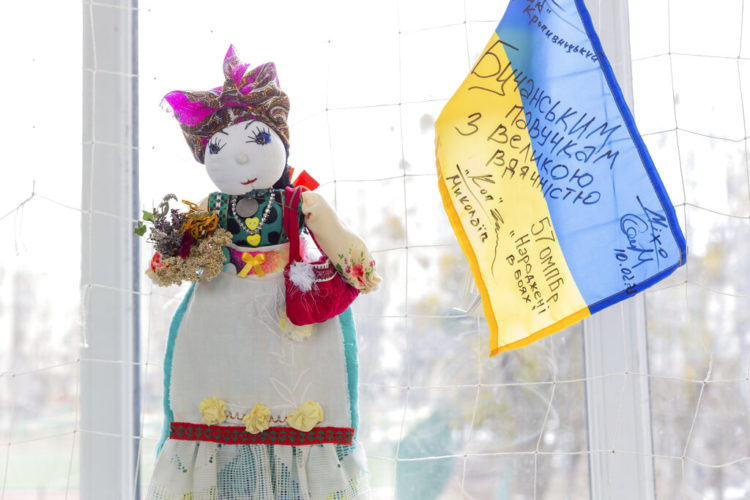By Jacqui Banaszynski
A large property sprawls on the north side of the state highway that runs from mountain cabin in the Washington Cascades to the town where I buy groceries. At least I assume It’s a large property. No buildings are visible from the road, but two large timbers stand as a sentinel gate at the entry road — usually markers of something substantive tucked into the foothills beyond.
I never paid much mind to that entry; there are many more, and many grander, along my route. But late last winter, when I drove by one day, a flag flew from the usually bare timbers, a bold stripe of blue over an equal-sized stripe of yellow: the flag of Ukraine, flying in support of the country after the Feb. 24, 2022, invasion by Russian President Vladimir Putin.
In the following months, I saw similar displays almost everywhere I looked: flying from a neighbor’s porch in Seattle or posted in a coffee shop window. I, like many, peppered my social media feed with images of blue and gold — sky and wheat — which can be found again and again in art, nature and design. Support for embattled Ukraine, which had defied most expectations by refusing to yield its toehold on 1991 democracy since the collapse of the Soviet Union, was widespread.
That was a year ago. The invasion that Putin expected to be a quick romp continues to grind on, with no near end in sight. Both sides are dug in. The body count of soldiers, mercenaries, civilians and journalists rises. Medieval and baroque cities are reduced to rubble, lush fields to graveyards. The United Nations counts more than 8 million Ukrainian refugees in other European countries, while another 8 million have been displaced within the country; that’s more than a quarter of the pre-war population, and includes, I’ve read, half of the children of Ukraine.
And that flag atop the timber on the mountain highway? It still flies. But this week, as I drove by, I noticed how faded it is, the colors no longer bold and bright. It struck me as a sad and inevitable testament to the passage of time, the grind of war and the impatience of the modern attention span.
I am not immune to that weariness. My interest in Ukraine — several visits and many friends from there — is intense, but compassion fatigue is real. I scour my go-to sites each morning for news, but often find myself bookmarking stories, telling myself I’ll read them later. I chastise myself for not paying the same attention to other situations in the world that deserve it. I try to remind myself that I have a life to attend to. So I calculate my household budget, write a check when I can and continue to scan the headlines.
No surprise that there has been uptick in headlines and broadcast bits recently, as the one-year anniversary of the war neared. I have been grateful for that nag to my attention. It has deepened my appreciation for the positive — if I dare call it that — that has ground on side-by-side with the negative stubbornness as the war: press coverage. It doesn’t own the headlines or airwaves with the same volume it did last spring, but it hasn’t been abandoned, at least not by the big mastheads. As journalism award season rolls out, expect to see deserved honor given to stories from the front and to insightful backgrounders about everything the war touches: politics, culture, the economy. This week’s surprise visit to Kyiv by U.S. President Joe Biden added juice, but didn’t change the foundations of purposeful coverage.
As this anniversary neared, it was my intent to gather a collection of coverage that stands out. I appreciate those who stepped up to help, but also realize it is folly to try to capture a representative sampling. That is something for historians to do in the decades to come.
For now, I offer a range of pieces that recommended by others and that have captured, and held, my attention. Some represent excellent writing craft. Some context needed for deeper understanding. Many — so many — moments of humanity amid the horror. There is no ranking to these recommendations. Bookmark them, if you will, and read as you can for what you learn, about a crucible situation and the journalism that chronicles it.
My own list of of recommended reads is too long to include, but I would suggest:
Many of these stories sit behind paywalls. But some news organizations have opened their war coverage landing pages and, if not, you can access stunning journalism with a few pennies for a six-month subscription. You can also check with your local library; many provide access to major news sites.
Read to know what's going on. Read to learn the craft. Read to be inspired by those doing the best journalism under the worst conditions.
A large property sprawls on the north side of the state highway that runs from mountain cabin in the Washington Cascades to the town where I buy groceries. At least I assume It’s a large property. No buildings are visible from the road, but two large timbers stand as a sentinel gate at the entry road — usually markers of something substantive tucked into the foothills beyond.
I never paid much mind to that entry; there are many more, and many grander, along my route. But late last winter, when I drove by one day, a flag flew from the usually bare timbers, a bold stripe of blue over an equal-sized stripe of yellow: the flag of Ukraine, flying in support of the country after the Feb. 24, 2022, invasion by Russian President Vladimir Putin.
In the following months, I saw similar displays almost everywhere I looked: flying from a neighbor’s porch in Seattle or posted in a coffee shop window. I, like many, peppered my social media feed with images of blue and gold — sky and wheat — which can be found again and again in art, nature and design. Support for embattled Ukraine, which had defied most expectations by refusing to yield its toehold on 1991 democracy since the collapse of the Soviet Union, was widespread.
That was a year ago. The invasion that Putin expected to be a quick romp continues to grind on, with no near end in sight. Both sides are dug in. The body count of soldiers, mercenaries, civilians and journalists rises. Medieval and baroque cities are reduced to rubble, lush fields to graveyards. The United Nations counts more than 8 million Ukrainian refugees in other European countries, while another 8 million have been displaced within the country; that’s more than a quarter of the pre-war population, and includes, I’ve read, half of the children of Ukraine.
And that flag atop the timber on the mountain highway? It still flies. But this week, as I drove by, I noticed how faded it is, the colors no longer bold and bright. It struck me as a sad and inevitable testament to the passage of time, the grind of war and the impatience of the modern attention span.
Stories that fight compassion fatigue
I am not immune to that weariness. My interest in Ukraine — several visits and many friends from there — is intense, but compassion fatigue is real. I scour my go-to sites each morning for news, but often find myself bookmarking stories, telling myself I’ll read them later. I chastise myself for not paying the same attention to other situations in the world that deserve it. I try to remind myself that I have a life to attend to. So I calculate my household budget, write a check when I can and continue to scan the headlines.
No surprise that there has been uptick in headlines and broadcast bits recently, as the one-year anniversary of the war neared. I have been grateful for that nag to my attention. It has deepened my appreciation for the positive — if I dare call it that — that has ground on side-by-side with the negative stubbornness as the war: press coverage. It doesn’t own the headlines or airwaves with the same volume it did last spring, but it hasn’t been abandoned, at least not by the big mastheads. As journalism award season rolls out, expect to see deserved honor given to stories from the front and to insightful backgrounders about everything the war touches: politics, culture, the economy. This week’s surprise visit to Kyiv by U.S. President Joe Biden added juice, but didn’t change the foundations of purposeful coverage.
As this anniversary neared, it was my intent to gather a collection of coverage that stands out. I appreciate those who stepped up to help, but also realize it is folly to try to capture a representative sampling. That is something for historians to do in the decades to come.
A small sampling of coverage
For now, I offer a range of pieces that recommended by others and that have captured, and held, my attention. Some represent excellent writing craft. Some context needed for deeper understanding. Many — so many — moments of humanity amid the horror. There is no ranking to these recommendations. Bookmark them, if you will, and read as you can for what you learn, about a crucible situation and the journalism that chronicles it.
- Brian Bonner worked with me at the St. Paul Pioneer Press in Minnesota, then was for many years the chief editor off the English-language weekly Kyiv Post. He now moves back and forth between Kyiv, Germany, Poland and the U.S., but always with his attention on his adopted home. Storyboard interviewed Bonner in the early days of the war and has leaned on him since for thoughts about what to follow in the news. He noted two pieces that stood out for him in recent days:
- An exclusive from CNN’s Nick Paton Walsh, co-reported with Darya Tarsova and Jo Shelley, about the Putin’s meatgrinder of bodies. The story focuses on convicts being recruited — or maybe sentenced — to the front, and explains the insidious relationship between Wagner, the private mercenary company, and a Russian Ministry of Defense desperate for soldiers. Consider the ingenuity and courage required to report this piece.
- A simple but memorable example of reporting about the one to represent the many: “The little girl who ‘died of fear’ in a Ukrainian cellar” by Richard Spencer of The Times of London. With restraint that adds to the power, it tells the story of Elya, a girl who spent the last months of her fifth year in a basement with her grandparents until she became sick and died. The entire time, according to people who were with her, she was scared. The story is short but carries surprising context about people’s torn allegiances between Ukraine and Russia
- SANA SIWOLOP is a Ukrainian-American who teaches journalism at St. John’s University in Queens, New York, and has freelanced for several large mastheads, including The New York Times. She specializes in coverage of science, medicine and business. She recommended checking into Rubryka, a Kyiv-based news site, and specifically mentioned the section "She's Got It." From Siwolop: “I often gravitate toward intricate narrative storytelling, but this site at Rubryka has been consistently providing solutions-oriented service pieces and profiles in a nation where the perspective of women is too often ignored or overlooked. Founder Anastasis Rudenko was just named a Solutions Journalism Network 2023 LEDE fellow.”
- I read two affecting pieces about women who ran businesses with their husbands until war intervened. The men were killed, their bodies not yet recovered from the far eastern war zones. Both women continued to juggle family and business needs, and now devote large portions of their proceeds to support Ukrainian troops. One of the women is a candlemaker who created a new line of candles called “Vital,” in honor of her husband, Vitaly, and sold enough to buy a pick-up truck for the military.
- Christina Frangou recommended the consistent work of Canada Globe and Mail war correspondent. Among them, how the staff at a hospital in Kherson keep children safe, the profile of a Canadian sniper facing a Russian onslaught and a personal account of covering the war.
- Claire Gordon, whose father fled the Nazis when he was 13, suggests following the BBC, especially radio ionterviews of Ukrainian refugees: “It is important to how ordinary Ukrainians are still keeping on, working, selling crafts, etc. and trying to survive. Contrary to many commentators, they are not just sitting around waiting for a handout.”
My own list of of recommended reads is too long to include, but I would suggest:
- Alissa Rubin on poetry as necessary gear she carries into war zones. Rubin has reported for 15 years for The New York Times from some of the world’s toughest conflicts. This personal essay is a meditation on what she reads in those fraught places, and why.
- Again, The New York Times, with a recent story by Jeffrey Gettleman about the young Ukrainian couple who went to the front together, fought in a trench together and died their together. Before you dismiss this as an easy sob story, consider the opening of a powerful nut graf:
- What ultimately happened to Taras and Olha, a middle-class husband and wife who shared a trench on the front line, and died in it, represents the hole in Ukrainian society that plunges deeper every day. No part of this country, even quiet places like Kropyvnytskyi, where Taras and Olha were mapping out their futures, has been spared.
- For that matter, scan The New York Times Russia-Ukraine War landing page for stories that speak to you. Their photo coverage alone is worth a subscription. Many friends have issues with The New York Times for a lot of reasons, but their war coverage is unparalleled. You’ll find a profile of a Kyiv middle-school teacher who traded her schoolbooks for a rifle to join the front. Also dive into work by ESPN writer and author Wright Thompson, whose coverage of the Ukrainian soccer team offers insight into passion as only Thompson can.
Many of these stories sit behind paywalls. But some news organizations have opened their war coverage landing pages and, if not, you can access stunning journalism with a few pennies for a six-month subscription. You can also check with your local library; many provide access to major news sites.
Read to know what's going on. Read to learn the craft. Read to be inspired by those doing the best journalism under the worst conditions.



